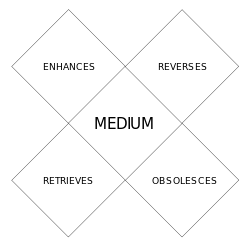Tetrad of media effects

Generally speaking, a tetrad is any set of four things. In Laws of Media (1988) and The Global Village (1989),[1] published posthumously, Marshall McLuhan summarized his ideas about media in a concise tetrad of media effects. The tetrad is a means of examining the effects on society of any technology/medium (put another way: a means of explaining the social processes underlying the adoption of a technology/medium[2]) by dividing its effects into four categories and displaying them simultaneously. McLuhan designed the tetrad as a pedagogical tool, phrasing his laws as questions with which to consider any medium:
- What does the medium enhance?
- What does the medium make obsolete?
- What does the medium retrieve that had been obsolesced earlier?
- What does the medium flip into when pushed to extremes?
The laws of the tetrad exist simultaneously, not successively or chronologically, and allow the questioner to explore the "grammar and syntax" of the "language" of media. McLuhan departs from his mentor Harold Innis in suggesting that a medium "overheats", or reverses into an opposing form, when taken to its extreme.[3]
Visually, a tetrad can be depicted as four diamonds forming an X, with the name of a medium in the center. The two diamonds on the left of a tetrad are the Enhancement and Retrieval qualities of the medium, both Figure qualities. The two diamonds on the right of a tetrad are the Obsolescence and Reversal qualities, both Ground qualities.[4]
- Enhancement (figure): What the medium amplifies or intensifies. For example, radio amplifies news and music via sound.
- Obsolescence (ground): What the medium drives out of prominence. Radio reduces the prominence of print and the visual.
- Retrieval (figure): What the medium recovers which was previously lost. Radio returns the spoken word to the forefront.
- Reversal (ground): What the medium does when pushed to its limits. Acoustic radio flips into audio-visual TV.
See also
- Hot and cool media
- Time- and space-bias
- Figure and ground (media)
- Media ecology
Further reading
- "Laws of Media: The Pentad and Technical Syncretism". Zingrone, Frank. McLuhan Studies 1 (1991).
External links
- Augmented reality (AR) researcher Helen Papagiannis applies the tetrad to AR at ARE2011 in Silicon Valley.
- The tetrad applied to radio, the press, and the Western on the Ginko Press website.
- Applying the Laws of Media in the software testing field (with a good, clear introduction to the topic in general) - "McLuhan for Testers"
Footnotes
- ↑ Full title: The Global Village: Transformations in World Life and Media in the 21st Century
- ↑ , Meta-Four-Play: McLuhan's Tetrad and Lévi-Strauss's Canonical Formula Part 2
- ↑ "Tetrad" in Old Messengers, New Media: The Legacy of Innis and McLuhan, a virtual museum exhibition at Library and Archives Canada
- ↑ Electric Language: Understanding the present, p. 28.
| ||||||||||||||||||||||